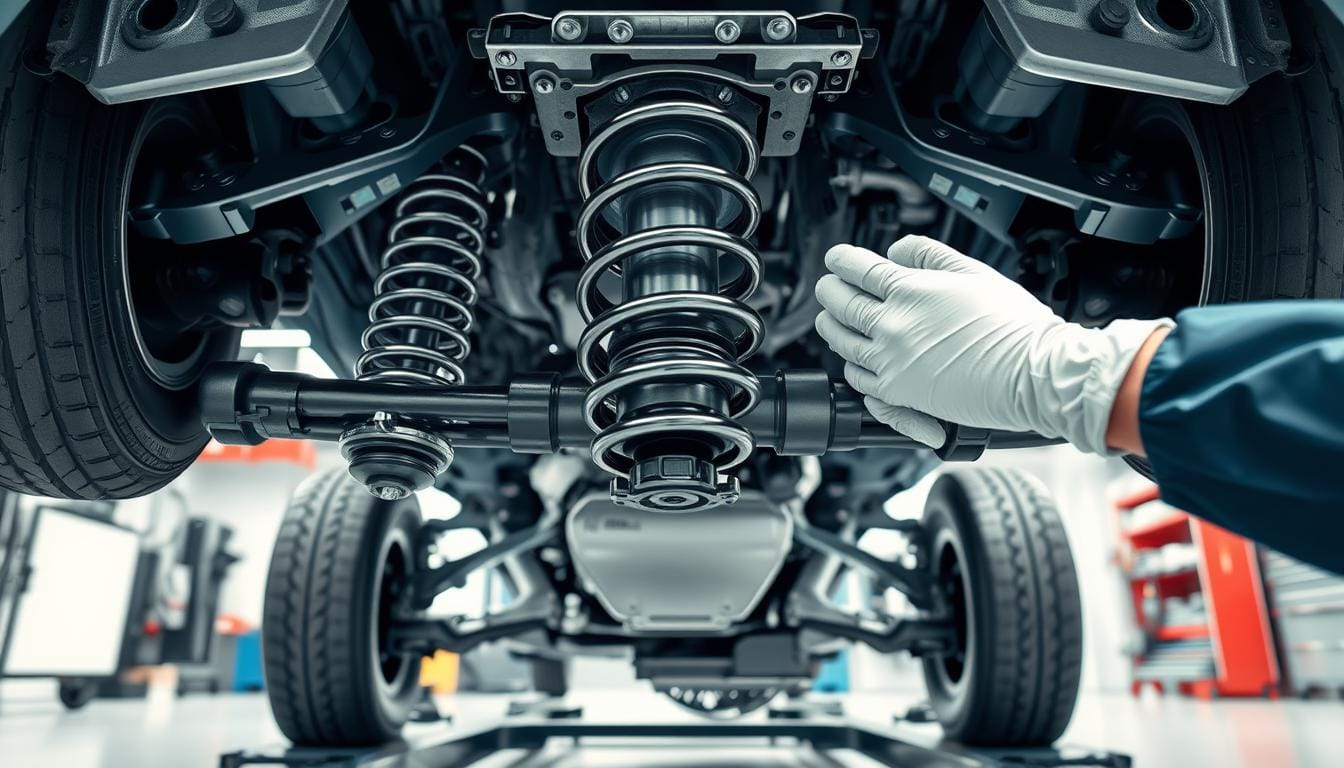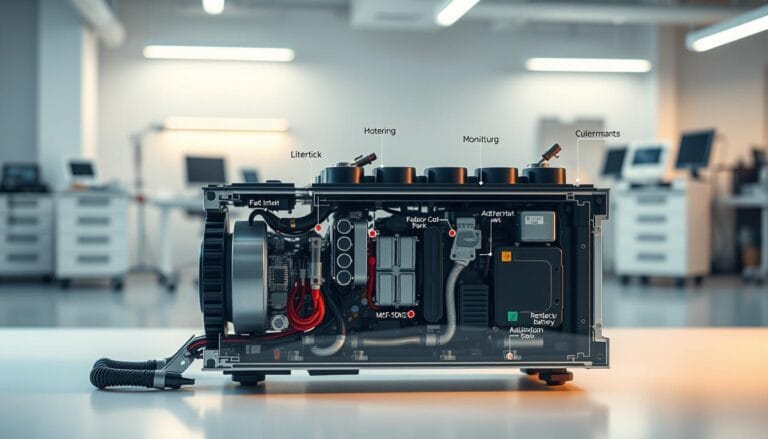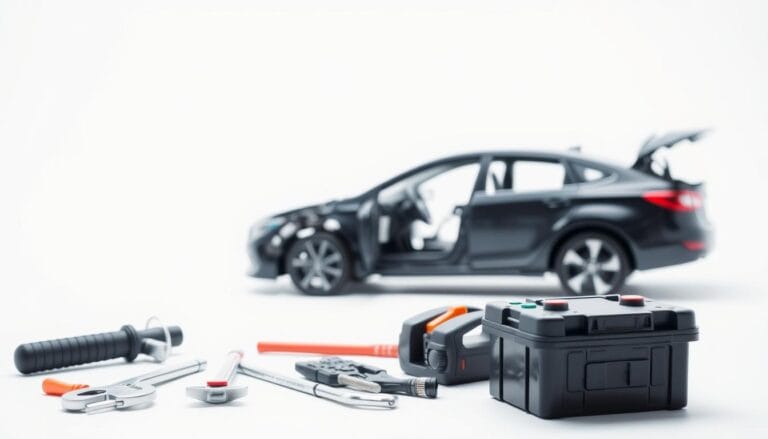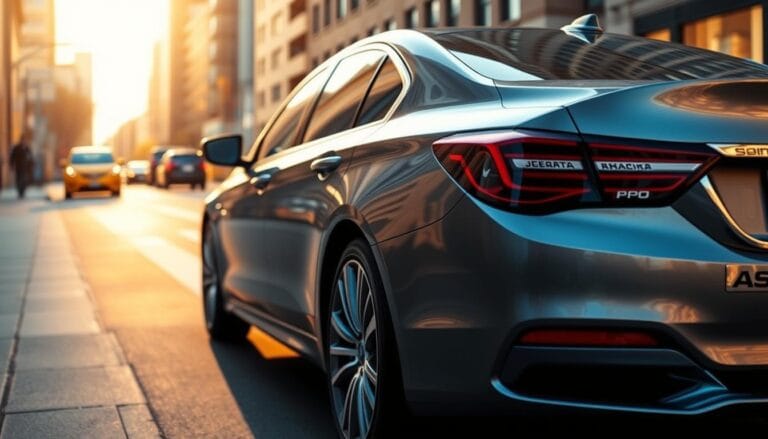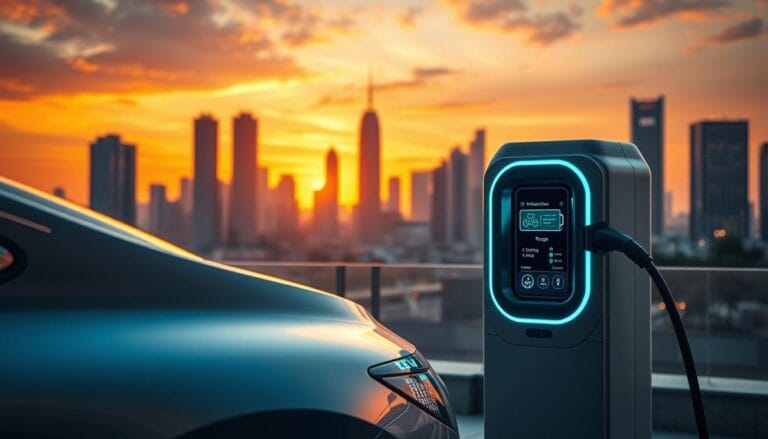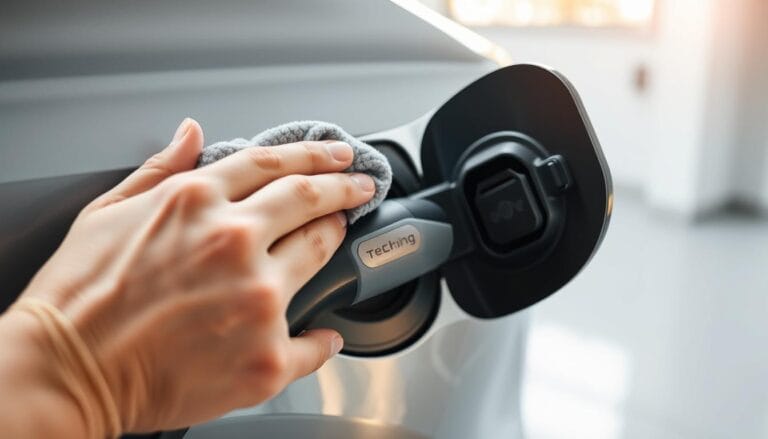EV Suspension Care: Handling Extra Battery Weight
Ever wondered why your electric vehicle feels different on the road? The secret lies beneath the surface – in its complex suspension system. Electric vehicles (EVs) carry a hidden weight challenge. Battery packs add 1,000 to 3,000 pounds, compared to traditional gas vehicles.
When you first transition to an electric vehicle, you’ll quickly notice something unique about its ride. The EV suspension care becomes critical because of the massive battery weight. This extra mass isn’t just a number – it’s a fundamental engineering challenge that affects every aspect of your driving experience.
Electric vehicle alignment and battery-powered car suspension require specialized attention. The increased weight puts tremendous stress on suspension components. This potentially accelerates wear and demands more frequent maintenance. Understanding these dynamics is key to keeping your EV performing at its best.
Table of Contents
Understanding the Importance of EV Suspension
Electric vehicles (EVs) are changing how we travel, with suspension systems being key to their success. They face special challenges due to battery weight and new tech.
Modern EV suspensions do more than just absorb shocks. They adjust to the road, making rides smoother and cars more stable.
What Makes Electric Vehicle Suspension Unique?
EV suspension needs special care because of a few key differences:
- Increased vehicle weight from battery packs
- Advanced smart air suspension capabilities
- Enhanced electronic monitoring systems
- Precision weight distribution requirements
The Role of Suspension in EV Performance
Your EV’s suspension affects its performance and how much energy it uses. A good suspension system also makes driving smoother.
Car makers like Ford say you should check your EV’s suspension every 15,000 miles. They use the MacPherson strut, a common type, in many high-end EVs.
A well-designed suspension system can significantly enhance ride quality by mitigating road imperfections and minimizing vibrations.
It’s important to know and take care of your EV’s suspension. This helps keep your car running well, lasting longer, and feeling better to drive.
Key Components of EV Suspension Systems
Electric vehicles need special suspension systems because of their unique weight and performance. The green vehicle suspension care is key, as battery weight can add up to 25% to the vehicle’s total mass.
Knowing the main parts of EV suspension is important for keeping your vehicle running well and safely. Modern electric cars use advanced suspension tech for smooth rides and sharp handling.
Springs and EV Shock Absorbers
EV shock absorbers are vital for handling the vehicle’s dynamics. They must be made to handle the extra weight of electric vehicle batteries. New designs use:
- Nitrogen gas-filled shock absorbers
- Enhanced damping systems
- Reinforced spring materials
Control Arms and Wheel Assemblies
The control arms and wheel assemblies in electric vehicles need extra strength. Electric motors provide instant torque, putting more stress on these parts. The MacPherson strut is a top choice for high-end electric vehicles.
Proper suspension maintenance can prevent costly repairs and ensure optimal vehicle performance.
Regular checks and proactive care are vital for your electric vehicle’s suspension. They help avoid early wear and damage.
Effects of Battery Weight on Ride Quality
Electric vehicles (EVs) face special challenges because of their heavy batteries. These batteries make up about 30-50% of the car’s weight. This greatly changes how the car rides and performs.
Your EV’s suspension has to work harder because of this extra weight. It’s important to design the suspension well to keep the ride comfortable. This balance is key for a good driving experience.
Changes in Handling Dynamics
The battery’s weight changes how your EV handles on different roads. It affects several important things:
- Cornering stability
- Braking responsiveness
- Acceleration performance
- Weight distribution
Impact on Comfort Levels
Keeping the suspension in good shape is important for comfort. The right suspension system, like those with four-airbag double wishbone designs, helps a lot. It reduces the weight that moves up and down and makes the ride better.
A well-maintained suspension system can enhance ride quality by up to 20%, providing smoother and more controlled driving experiences.
The electric motors’ instant torque needs a smart suspension system. It must handle quick acceleration without making the ride uncomfortable. Taking care of your EV’s suspension ensures a smoother, more enjoyable drive.
Regular Maintenance Practices for EV Suspension
Keeping your electric vehicle’s suspension in top shape is key for smooth rides and long life. EVs have special needs because of their heavy batteries and unique design. Regular care helps keep your car running well and comfortable.
- Regularly check suspension parts
- Look for uneven tire wear
- Check how shock absorbers are doing
- Deal with how battery weight affects the car
Inspecting for Wear and Tear
EVs face different stress on their suspension than regular cars. The heavy battery means you need to check more often. Watch for:
- Odd tire wear patterns
- Wear on suspension parts
- Alignment issues
Proper Adjustments for Battery Load
Understanding how battery weight changes your car’s feel is part of EV care. Here’s what to do:
- Get your suspension checked every year
- Check gas struts every 75,000 miles
- Make sure your wheels are aligned right
EVs cost less to maintain, about $300 to $500 a year. Being proactive with your suspension can save you money and keep your car running great.
Signs You Need Suspension Care
Your electric vehicle’s suspension system is key for smooth and safe driving. Spotting early warning signs can avoid expensive fixes and keep your EV in top shape. Road conditions like potholes and rough pavement can harm your vehicle’s performance quickly.
It’s vital to know the subtle signs of suspension problems for your EV’s alignment and health. Many EV owners might overlook these important signals that show your vehicle needs attention right away.
Unusual Noises and Vibrations
Look out for these warning signs of possible suspension issues:
- Clunking sounds when driving over bumps
- Squeaking or knocking noises during turns
- Excessive bouncing after hitting road imperfections
- Vibrations in the steering wheel
Changes in Steering Response
Your EV’s steering can show important signs about its suspension health. Watch for these key changes:
- Uneven tire wear suggesting misalignment
- Vehicle pulling to one side while driving straight
- Difficulty maintaining a steady driving line
- Increased steering wheel resistance
Experts say check your EV’s suspension system every year or every 12,000 miles. About 20% of vehicles have suspension issues that can be caught early with careful checks.
Early detection of suspension problems can save you thousands in repair costs.
Remember, your EV’s special weight and battery setup make it even more important to care for its suspension. Regular maintenance can make your suspension last up to 30% longer.
Adapting Your Driving Style
Driving an electric vehicle needs a special touch, mainly for its battery-powered car suspension. The car’s weight and advanced suspension systems require careful driving. This ensures a smooth ride.
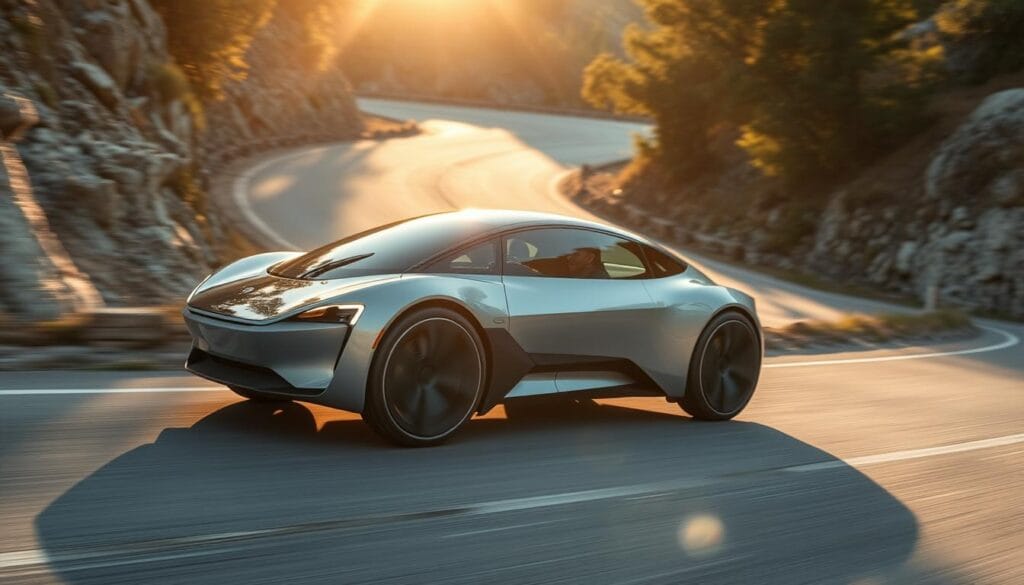
Driving an electric car means knowing how the heavy battery affects handling and suspension. The car’s electronic steering and suspension offer big benefits. They adjust to the road in real-time.
Navigating Bumps and Potholes
When you hit bumps or potholes, your driving can help your car’s suspension:
- Slow down before hitting bumps or potholes
- Steer smoothly and gradually
- Avoid sudden turns to reduce strain on the suspension
- Use the car’s adaptive suspension features when you can
Maintaining Stability during Turns
Electric cars often have a lower center of gravity because of the battery. This makes them more stable when turning. Strategic turning techniques can make your drive even better:
- Start turns early and slow down smoothly
- Use gentle, steady steering
- Let the car’s electronic stability control help
| Driving Technique | Suspension Impact | Performance Benefit |
|---|---|---|
| Smooth Acceleration | Reduced Mechanical Stress | Extended Suspension Lifespan |
| Gradual Braking | Minimized Weight Transfer | Improved Handling Stability |
| Predictive Driving | Less Sudden Load Changes | Enhanced Energy Efficiency |
By using these driving tips, you can keep your electric car’s suspension in top shape. This will also boost its performance and the efficiency of its battery-powered system.
Upgrading Your Suspension System
Electric vehicle owners face unique challenges with suspension performance. The added weight of battery packs needs special solutions. These solutions improve both energy-efficient and sustainable mobility suspension capabilities.
Upgrading your EV’s suspension system can greatly improve ride quality and vehicle dynamics. Aftermarket manufacturers have created advanced components. These are designed to meet the special needs of electric vehicles.
Performance Enhancement Options
- High-performance shock absorbers
- Specialized spring configurations
- Advanced control arm replacements
- Adaptive suspension systems
Balancing Investment and Performance
When thinking about suspension upgrades, weigh the benefits against your budget and driving needs. Not all upgrades are worth the cost. So, it’s important to do your research.
| Upgrade Type | Cost Range | Performance Impact |
|---|---|---|
| Basic Shock Absorbers | $200-$500 | Moderate Improvement |
| Advanced Adaptive Systems | $800-$2,000 | Significant Enhancement |
| Comprehensive Suspension Kit | $1,000-$3,000 | Complete Transformation |
Companies like FCS Auto Parts offer engineered solutions that often beat the original equipment quality. Their team of 60+ engineers creates components for electric vehicle suspension systems. These components are designed to meet the unique demands of EVs.
Environmental Factors Affecting Suspension
Electric vehicle suspension has special challenges from the weather and road conditions. Your care plan must handle different weather and road types. These can greatly affect how well your vehicle performs and lasts.

EV Suspension Care gets complex when we look at how different environments affect vehicle systems. Extreme temperatures and changing road conditions can change how the suspension works and stress its parts.
Impact of Seasonal Changes
Seasonal changes bring unique challenges for electric vehicle suspensions:
- Winter conditions with road salt increase corrosion risks
- Extreme cold can reduce suspension fluid viscosity
- High summer temperatures affect rubber and metal components
- Humidity levels impact suspension material performance
Road Conditions and Their Challenges
Different road surfaces test your EV’s suspension system. Urban streets with potholes, rough highways, and uneven terrain need strong suspension design.
Proper maintenance prevents premature wear and ensures optimal vehicle performance across diverse environmental conditions.
EVs need special care for their suspension due to their unique weight from battery packs. Knowing how environments affect your vehicle helps protect its suspension. This keeps it reliable for a long time.
DIY EV Suspension Care Tips
Keeping your electric vehicle’s suspension in top shape is easy. With some basic knowledge and tools, you can do simple checks. These help your EV run smoothly and avoid expensive fixes.
Basic Inspection Techniques
Electric vehicle suspension care needs your attention. Here are key steps to follow:
- Look for wear or damage on suspension parts
- Listen for odd noises while driving
- Check tire pressure every 30 days
- Rotate tires every 7,500 miles
When to Call in a Professional
Some issues need a pro’s touch. For electric vehicle alignment and complex maintenance, call a certified tech when:
- Unusual vibrations don’t go away
- Steering feels off
- Tire wear is uneven
- Vehicle height looks off
| Maintenance Task | Recommended Interval |
|---|---|
| Suspension strut replacement | 75,000 miles |
| Tire rotation | Every 7,500 miles |
| Comprehensive suspension check | Annually or every 15,000 miles |
Prevention is always better than expensive repairs. DIY care helps, but pro electric vehicle alignment and maintenance keep your EV safe and running well.
The Cost of Neglecting Suspension Care
Keeping your electric vehicle’s suspension in good shape is not just about comfort. It’s about protecting your investment. If you ignore your EV’s shock absorbers, you could face big financial losses. These problems go beyond just a bumpy ride.
Electric vehicles need less upkeep than traditional cars, but suspension care is key. The extra weight from batteries puts more stress on suspension parts. So, regular maintenance is a must.
Long-Term Performance Impacts
Ignoring suspension issues can lead to a chain of problems:
- Accelerated tire wear
- Reduced vehicle handling
- Decreased energy efficiency
- Potential safety risks
Avoiding Expensive Repairs
Regular checks can stop costly repairs before they start. Small problems like worn shock absorbers can turn into big, expensive fixes.
Prevention is always cheaper than repair when it comes to EV suspension systems.
EV owners should plan for annual suspension inspections. Suspension repairs can cost between $500 to $1,000. This depends on the car model and damage level. Regular maintenance can save you a lot of money over time.
By investing in routine EV shock absorbers maintenance and emission-free suspension care, you’ll keep your vehicle running well. You’ll also ensure your safety and extend your car’s life.
Future Trends in EV Suspension Technology
The car world is changing fast, with electric vehicle suspension leading the way. New tech is making cars smarter and more energy-efficient. This means your car will handle the road better and feel more connected to you.
New ideas in suspension are making cars perform better. AI and machine learning let parts of the car adjust on the fly. They look at the road, how you drive, and the car’s movements to make your ride smoother.
Car makers are working hard on better suspension for electric cars. They’re using advanced motors and control systems for quick adjustments. This means your car will be safer and more comfortable to drive.
The future of EV suspension is exciting. Cars will remember your favorite settings and adjust to different driving situations. As more people choose electric cars, these new suspension systems will shape the future of driving.

